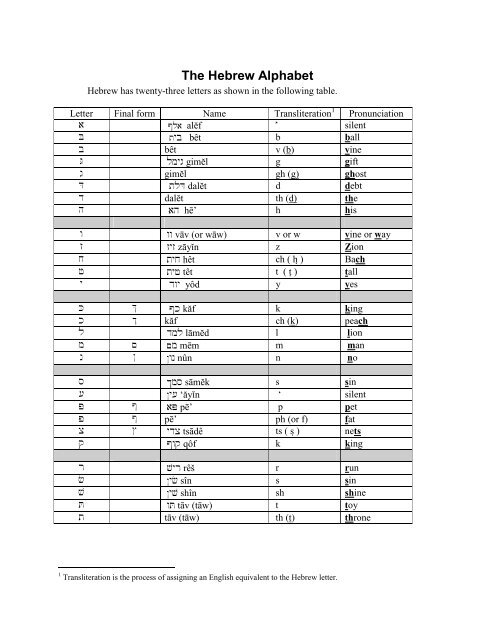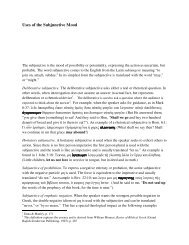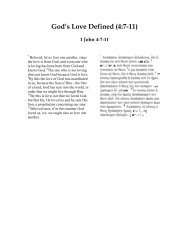LESSON ONE - The Hebrew Alphabet - Bible Greek on VideoPOD
LESSON ONE - The Hebrew Alphabet - Bible Greek on VideoPOD
LESSON ONE - The Hebrew Alphabet - Bible Greek on VideoPOD
You also want an ePaper? Increase the reach of your titles
YUMPU automatically turns print PDFs into web optimized ePapers that Google loves.
<str<strong>on</strong>g>The</str<strong>on</strong>g> <str<strong>on</strong>g>Hebrew</str<strong>on</strong>g> <str<strong>on</strong>g>Alphabet</str<strong>on</strong>g><br />
<str<strong>on</strong>g>Hebrew</str<strong>on</strong>g> has twenty-three letters as shown in the following table.<br />
Letter Final form Name Transliterati<strong>on</strong> 1 Pr<strong>on</strong>unciati<strong>on</strong><br />
a @la alĕf Y silent<br />
B tyb bêt b ball<br />
b bêt v (b) vine<br />
G lmyg gimĕl g gift<br />
g gimĕl gh (g) ghost<br />
D tlD dalĕt d debt<br />
d dalĕt th (d) the<br />
h ah hē’ h his<br />
w ww vāv (or wāw) v or w vine or way<br />
z zyz zāyĭn z Zi<strong>on</strong><br />
x tyx Ihêt ch Bach<br />
j tyj Itêt t tall<br />
y dwy yôd y yes<br />
K & @k kăf k king<br />
k $ kăf ch (k) peach<br />
l dml lāmĕd l li<strong>on</strong><br />
m ~ ~m mēm m man<br />
n ! !wn nûn n no<br />
s $ms sāmĕk s sin<br />
[ !y[ ‘ăyĭn ‘ silent<br />
P @ aP pē’ p pet<br />
p @ pē’ ph (or f) fat<br />
c # ydc tsādê ts ( s nets<br />
q @wq qôf k king<br />
r vyr rêš r run<br />
f !yf sîn s sin<br />
v !yv shîn sh shine<br />
T wT tāv (tāw) t toy<br />
t tāv (tāw) th (t) thr<strong>on</strong>e<br />
1 Transliterati<strong>on</strong> is the process of assigning an English equivalent to the <str<strong>on</strong>g>Hebrew</str<strong>on</strong>g> letter.
Notice the five groupings. <str<strong>on</strong>g>The</str<strong>on</strong>g>se are organized in four or five letters per group in order to<br />
help in the memorizati<strong>on</strong> process. It is far easier to memorize a group of four or five letters, then,<br />
<strong>on</strong>ce the group is memorized, move <strong>on</strong> to the next group. Memorize the letter, saying the name<br />
and writing down the letter many times. Do this until the whole alphabet can be written without<br />
hesitati<strong>on</strong>.<br />
BeGaD KeFaT<br />
Notice there are some letters that are repeated that c<strong>on</strong>tain a dot ( . ) within it (e.g., T). This dot is<br />
called a Daghesh Lene and indicates a hard pr<strong>on</strong>unciati<strong>on</strong>. <str<strong>on</strong>g>The</str<strong>on</strong>g>se letters are called begadkephat<br />
(a composite built <strong>on</strong> the names of the six letters tpkdgb) as a way to remember the six letters.<br />
<str<strong>on</strong>g>The</str<strong>on</strong>g>se letters are B, G, D, K, P, T. As you can see, <str<strong>on</strong>g>Hebrew</str<strong>on</strong>g> is written from right to left.<br />
Final Form<br />
<str<strong>on</strong>g>The</str<strong>on</strong>g>re are five letters that c<strong>on</strong>tain a final form. A final form letter should be used when that letter<br />
is in the last positi<strong>on</strong> of the word.<br />
Certain letters sound alike<br />
As you can tell some of the letter sound alike.<br />
s, f - S, as in See<br />
k, q - K, as in keep<br />
j, t - T, as in Tom<br />
b, w - V, as in Vine<br />
x, k - CH, as in Bach<br />
a, [ - Silent<br />
letter final form<br />
k<br />
$<br />
m<br />
~<br />
n<br />
!<br />
p<br />
@<br />
#<br />
c<br />
<str<strong>on</strong>g>The</str<strong>on</strong>g> Vowels<br />
Ancient <str<strong>on</strong>g>Hebrew</str<strong>on</strong>g> had no written vowels. <str<strong>on</strong>g>The</str<strong>on</strong>g> written vowels were added around AD 500 by the<br />
Masoretes who added them in order to preserve the language. It is not that the language did not<br />
use vowels; it is just that there was no written form until later. <str<strong>on</strong>g>The</str<strong>on</strong>g> speaker would add the vowel<br />
as necessary. For example, all verbs wi excep i<strong>on</strong> use e “a” sound w ile i s noun equivalent<br />
will use e “e” sound. <str<strong>on</strong>g>The</str<strong>on</strong>g> system they developed is called the pointing system whose intenti<strong>on</strong><br />
is not to alter the established written form. <str<strong>on</strong>g>The</str<strong>on</strong>g> pointing added small dots and tiddles below and<br />
above the character.
Drs. Pratico and Van Pelt give the following example, “Le us use e Englis ransla i<strong>on</strong><br />
of Deut. 6:5 as an example: ‘Love e Lord your God wi all your ear .’ Wi ou e vowels,<br />
we are left with a series of c<strong>on</strong>s<strong>on</strong>ants, much like the ancient written form of <str<strong>on</strong>g>Hebrew</str<strong>on</strong>g>: Lv th Lrd<br />
yr Gd wth ll yr hrt. In order to read this sentence out loud, you would need to rely <strong>on</strong> your<br />
knowledge of English and supply the necessary vowels. In the same way, when Joshua read the<br />
entire law of Moses to the Israelites (Josh 8), he had before him a c<strong>on</strong>s<strong>on</strong>antal text with no<br />
vowels. T is required Jos ua o supply from memory e necessary vowels w en reading.” 2<br />
In the <str<strong>on</strong>g>Hebrew</str<strong>on</strong>g>, ere are e “a,” “e,” “i,” “o,” and “u” sounds as s own below.<br />
Group Name Sign Positi<strong>on</strong> Sound Example<br />
a Qamets 3<br />
'<br />
'a a, as in car b'a father<br />
:<br />
Pathach<br />
;a a, as in bat t;B daughter<br />
E<br />
e Tsere<br />
ea e, as in they lEa God<br />
Tsere-Yod yE yea e, as in they tyeB house<br />
,<br />
I<br />
I<br />
Seghol<br />
,a e, as in met l
Daghesh Forte<br />
<str<strong>on</strong>g>The</str<strong>on</strong>g> Daghesh forte is a dot in the letter which indicated <strong>on</strong>e is to double the c<strong>on</strong>s<strong>on</strong>ant in which it<br />
occurs. It is the same mark as the dagesh lene placed in the six c<strong>on</strong>s<strong>on</strong>ants. For example in, !eB;h<br />
(habben) the bet is doubled.<br />
<str<strong>on</strong>g>The</str<strong>on</strong>g> rules for a dagesh forte are as follows:<br />
1. A dot in any letter other than a BaGad KeFaT letter is a dagesh forte.<br />
2. A dagesh forte is always found immediately after a vowel, whereas a dagesh lene is<br />
never found after a vowel.<br />
Syllables<br />
<str<strong>on</strong>g>The</str<strong>on</strong>g> word syllable comes to the English from the <str<strong>on</strong>g>Greek</str<strong>on</strong>g> syllabē meaning, “ a w ic olds<br />
oge er,” and applies o ow a word is pr<strong>on</strong>ounced. A word or par of a word pr<strong>on</strong>ounced wi a<br />
single, uninterrupted sound of the voice is a syllable. A <str<strong>on</strong>g>Hebrew</str<strong>on</strong>g> word has as many syllables as it<br />
has separate c<strong>on</strong>s<strong>on</strong>ants. In general, words are broken up into syllables using the following rules:<br />
All syllables in a word must begin with a c<strong>on</strong>s<strong>on</strong>ant.<br />
A syllable must include <strong>on</strong>e full vowel or a half vowel.<br />
<str<strong>on</strong>g>The</str<strong>on</strong>g>re are as many syllables as there are full vowels.<br />
<str<strong>on</strong>g>Hebrew</str<strong>on</strong>g> syllables are either open or closed. An open syllable is <strong>on</strong>e that ends in a vowel and<br />
is normally a l<strong>on</strong>g vowel. A closed syllable is <strong>on</strong>e that ends in a c<strong>on</strong>s<strong>on</strong>ant and the vowel will<br />
normally be short.<br />
Examples are:<br />
r'b'D da/bar<br />
~yik'l.m me/la/kim<br />
<str<strong>on</strong>g>Hebrew</str<strong>on</strong>g> syllable identificati<strong>on</strong> has the following formal naming c<strong>on</strong>venti<strong>on</strong>:<br />
Antepenultima - 1 st syllable<br />
Penultima - 2 nd syllable<br />
Ultima - last syllable<br />
EXAMPLE: ~YIK'L.M ME/LA/KIM<br />
~yik 'l .m<br />
Ultima Penultima Antepenultima<br />
Last syllable 2 nd syllable 1 st syllable<br />
Accent Marks
<str<strong>on</strong>g>The</str<strong>on</strong>g>re are twenty-seven prose and twenty-<strong>on</strong>e poetic accents in the <str<strong>on</strong>g>Hebrew</str<strong>on</strong>g> 4 . <str<strong>on</strong>g>The</str<strong>on</strong>g> accent marks<br />
are about evenly divided between those that are placed above and those placed below the word.<br />
<str<strong>on</strong>g>The</str<strong>on</strong>g>re are two main purposes for accent marks in the <str<strong>on</strong>g>Hebrew</str<strong>on</strong>g>. <str<strong>on</strong>g>The</str<strong>on</strong>g> first is to mark the t<strong>on</strong>al<br />
syllable, and sec<strong>on</strong>dly to serve as punctuati<strong>on</strong> marks.<br />
1. T<strong>on</strong>al syllable mark. <str<strong>on</strong>g>The</str<strong>on</strong>g> accented syllable is normally the last syllable of the word, but it<br />
may also be the next to last. In the case where words are accented <strong>on</strong> any syllable other<br />
than the last the additi<strong>on</strong> of a munah ( / ) is added to the bottom of the word. For example,<br />
%elm<br />
2. Punctuati<strong>on</strong> marks. <str<strong>on</strong>g>The</str<strong>on</strong>g>re are two type of punctuati<strong>on</strong> marks:<br />
Disjunctive (separating). <str<strong>on</strong>g>The</str<strong>on</strong>g>re are three disjunctive marks; (i) <strong>on</strong>e to mark the<br />
end of the first half of the verse known as the ‘atnah (^) and placed below the<br />
accented syllable of the last word of the first half of the verse; and (ii) <strong>on</strong>e to mark<br />
the end of the verse end known as the silluq ( ) and placed below the accented<br />
syllable of the last word in the last half of the verse; (iii) the end of the verse is<br />
denoted by the sof passuq (:) that identifies the end of the sentence.<br />
C<strong>on</strong>junctive (joining).<br />
A final word<br />
<str<strong>on</strong>g>The</str<strong>on</strong>g> system of pr<strong>on</strong>unciati<strong>on</strong> recommended throughout this book stresses the use of the<br />
Internati<strong>on</strong>al Ph<strong>on</strong>etic Associati<strong>on</strong> (IPA) system. Recognized symbols of the IPA system provide<br />
exact pr<strong>on</strong>unciati<strong>on</strong> applied to any language or culture.<br />
Practice<br />
A. Memorize the c<strong>on</strong>s<strong>on</strong>ants (It is helpful to memorize the alphabet in groups of 5).<br />
B. Memorize the vowels.<br />
C. Memorize the half-vowels.<br />
D. Transliterate the following proper names (remember – right to left):<br />
1. ~xl tyB (Mic. 5:1)<br />
2. wymynB (Gen. 42:4)<br />
3. dwD (1 Sam. 16:23)<br />
E. Write the following in <str<strong>on</strong>g>Hebrew</str<strong>on</strong>g> (remember – right to left):<br />
1. ysr’l<br />
2. hlk<br />
3. ywntn<br />
4 That is, for the BHS. This text does not use accent marks. <str<strong>on</strong>g>The</str<strong>on</strong>g>y are <strong>on</strong>ly referenced here in order to let you know<br />
that they exist and that you may refer to William R. Scott, A Simplified Guide to BHS (BIBAL Press, 1987).




